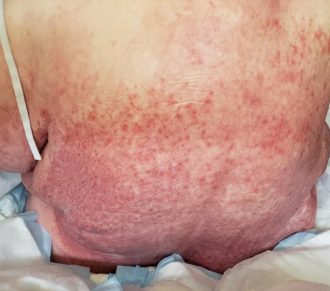Rare Pemphigus Disease: Wound Care
 Figure: 1 Initial presentation of patient’s back
Figure: 1 Initial presentation of patient’s backLearn more
Interested in learning how you can have a practice in wound care and become fellowship trained? Vohra Wound Physicians is hiring.
History
An 84-year-old female was admitted to a skilled nursing facility with large surface area wounds to the entirety of her back (Figure 1), and bilateral posterior lower extremities of 10 days duration. She previously had similar outbreaks over the past 40 years that were limited to her infra-mammary folds and abdomen. There was no history of fever, malaise, weight loss, recent viral illness, or trauma. On physical examination, she had diffuse erosions to her back and posterior lower extremities that measured approximately 2200 cm2 in total. She had no relevant family history. Her medical history was pertinent for Hailey-Hailey disease, which she was diagnosed via biopsy in the 1970s.
Review
Hailey-Hailey disease, or benign familial chronic pemphigus, is a rare autosomal dominant disease that can be difficult to diagnose due to wide variation in clinical features. Classically, the disease initially presents after puberty with vesicles and erosions of the skin in flexural regions and skin folds, although the morphology and distribution of lesions can vary greatly.1 It is a chronic and often painful condition with multiple recurrences over decades. In general, friction and heat exacerbate the lesions, and secondary infection with bacteria and yeast is common. Also complicating the diagnosis, only two-thirds of patients have a family history of the disease.2 This often leads to delay in diagnosis, causing undue pain, psychological stress, and impaired quality of life.3 Fortunately, skin biopsy can differentiate Hailey-Hailey from other pemphigus disorders and prognosis is generally good with proper treatment. The true prevalence of Hailey-Hailey is not known given the high likelihood of misdiagnosis of the disease.2. Hailey-Hailey disease can be difficult to distinguish from other dermatological diseases, and therefore is important to keep in a differential diagnosis. In this case, the patient had biopsy proven disease which made diagnosis easy.
Treatment
In general, topical corticosteroids, topical antibiotics, and cool compresses are used to treat mild disease. In more severe cases, systemic antibiotics or topical tacrolimus can be used. Refractory disease has been shown to respond to botulism injection, methotrexate, CO2 laser ablation, and even surgical excision. In this case treatment with silver sulfadiazine was superior to triamcinolone in this case, likely due to superinfection which is common in this disease. Treatment was begun with 1% Triamcinolone cream applied twice daily with only modest improvement over the subsequent 7 days. Treatment was then changed to silver sulfadiazine applied daily, with a subsequent 37% decrease in wound surface area after 1 week. She was discharged from the SNF soon thereafter and lost from follow up.
- Pemphigoid disease has a broad differential including rare diseases such as Hailey-Hailey.
- Skin biopsy is an important tool in the diagnosis of dermatological diseases.
- Secondary infection of skin erosions can significantly hinder treatment.
References
- Nellen RG, Steijlen PM, van Steensel MA, et al. Disorders of Cornification Caused by Defects in Intracellular Calcium Pumps: Mutation Update and Database for Variants in ATP2A2 and ATP2C1 Associated with Darier Disease and Hailey-Hailey Disease. Hum Mutat. 2017 Apr;38(4):343-356.
- Burge SM. Hailey-Hailey disease: the clinical features, response to treatment and prognosis. Br J Dermatol 1992; 126:275.
- Gisondi P, et al. Severe impairment of quality of life in Hailey-Hailey disease. Acta Derm Venereol 2005; 85:132.
- Almurayshid, Abdurrahman. “Familial Benign Pemphigus Pathology.” Familial Benign Pemphigus Pathology | DermNet NZ, 2015, dermnetnz.org/topics/familial-benign-pemphigus-pathology.
Make a Difference in
Patients' Lives and
Your Own Career
JOIN VOHRA WOUND CAREStay up to date on the latest in wound care.
Join our mailing list today!

Thank You For Successfully Registering!
Stay tuned for the latest news and treatments in wound care tailored for medical professionals like you.
